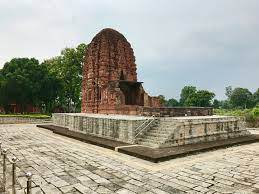Sirpur Lakshmana Temple, Chhattisgarh

Address
Sirpur Lakshmana temple, SH 9, Sirpur, Chhattisgarh 493445
Diety
Lakshmana
Introduction
Sirpur Lakshmana Temple, monuments from the 5th to 12th centuries in Mahasamund district of the state of Chhattisgarh, India.
Puranic Significance
The Lakshmana temple, also spelled Laxman temple, is a 7th-century brick temple, mostly damaged and ruined.Sirpur became a major archaeological site after it was visited in 1882 by Alexander Cunningham, a colonial British India official.The site remained neglected in early 20th-century during the decades of the World Wars, and excavations resumed in 1953.
Special Features
The Lakshmana Temple in Sirpur boasts a remarkable entrance to the garbhagriya (sanctum), adorned with intricate carvings. Above the lintel of the sanctum door, there are depictions of a reclining Vishnu on Sesha (Anantasayana Vishnu) and a panel illustrating a scene from the Bhagavata Purana featuring Krishna. Surrounding the door, there are bands of carvings portraying the ten avatars of Vishnu, scenes from daily life, and couples in various stages of courtship and mithuna (intimate connection).
This temple is situated on a stone jagati platform, measuring approximately 40 feet by 80 feet, providing ample space for circumambulation. The primary construction material of the temple is brick, with the exception of the finely carved frame encircling the garbhagriya (sanctum), which is made of stone. The sanctum’s entrance faces eastward. In front of the sanctum, there is the outline of an antarala (vestibule) and an oblong mandapa (ceremonial community hall). Although the hall once featured spaces for pillars, these have regrettably been lost to the ravages of time. Apart from the sanctum and its tower, much of the temple now lies in ruins.
The stone frame surrounding the sanctum on the exterior forms a square of 22×22 feet, while the interior sanctum itself measures about 10×10 feet square. The walls of the sanctum are plain, following the typical style of Hindu temples. Sadly, the original deity that resided in the sanctum is missing, but site management has installed several small statues, sourced from the ruins, for the benefit of visitors.
Century/Period/Age
12th century A.D.
Nearest Bus Station
Sirpur
Nearest Railway Station
Mahamasund
Nearest Airport
Raipur




